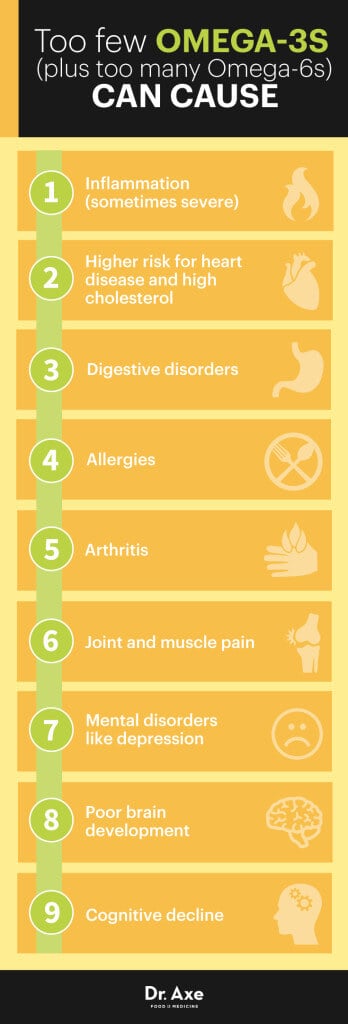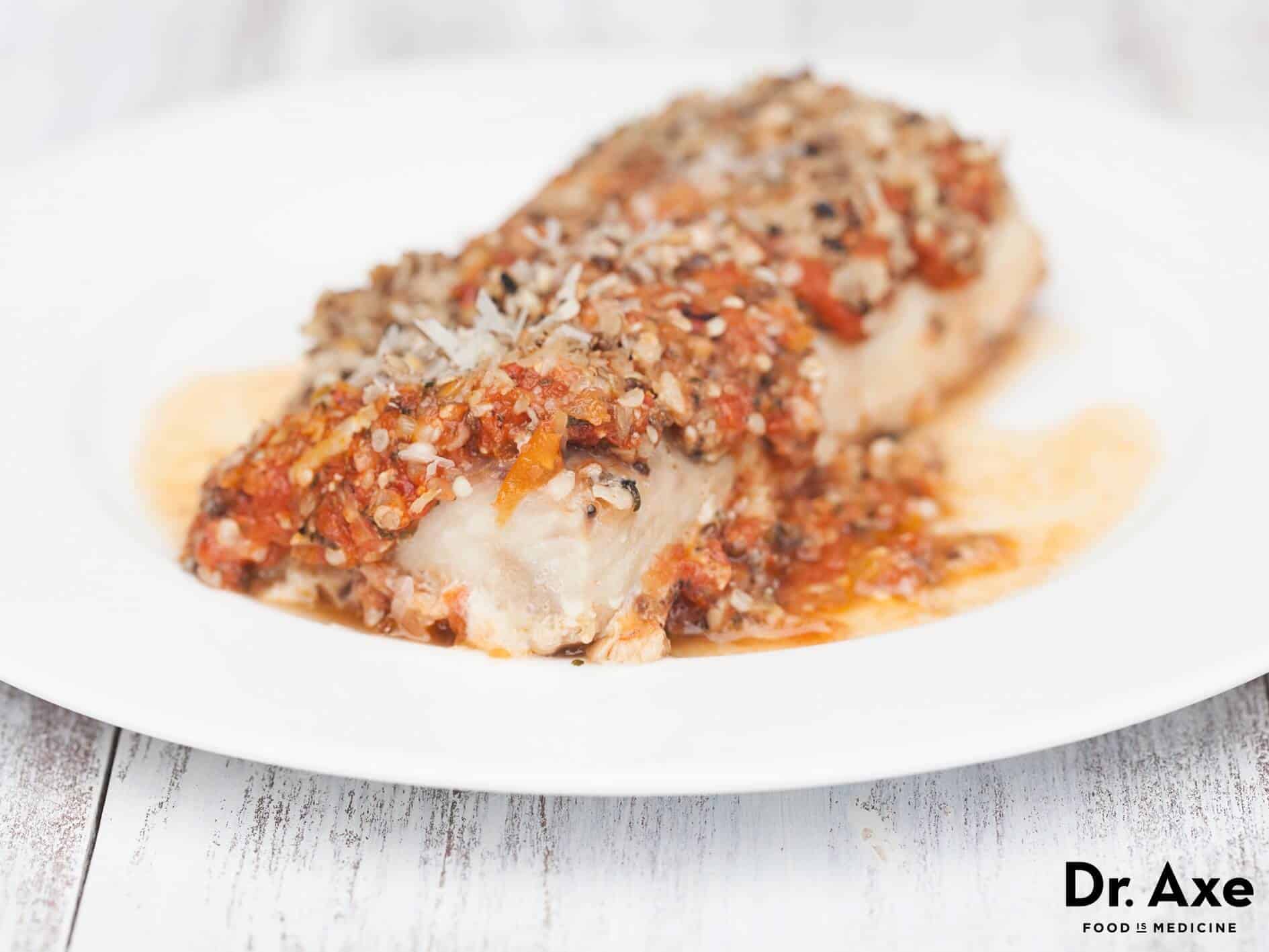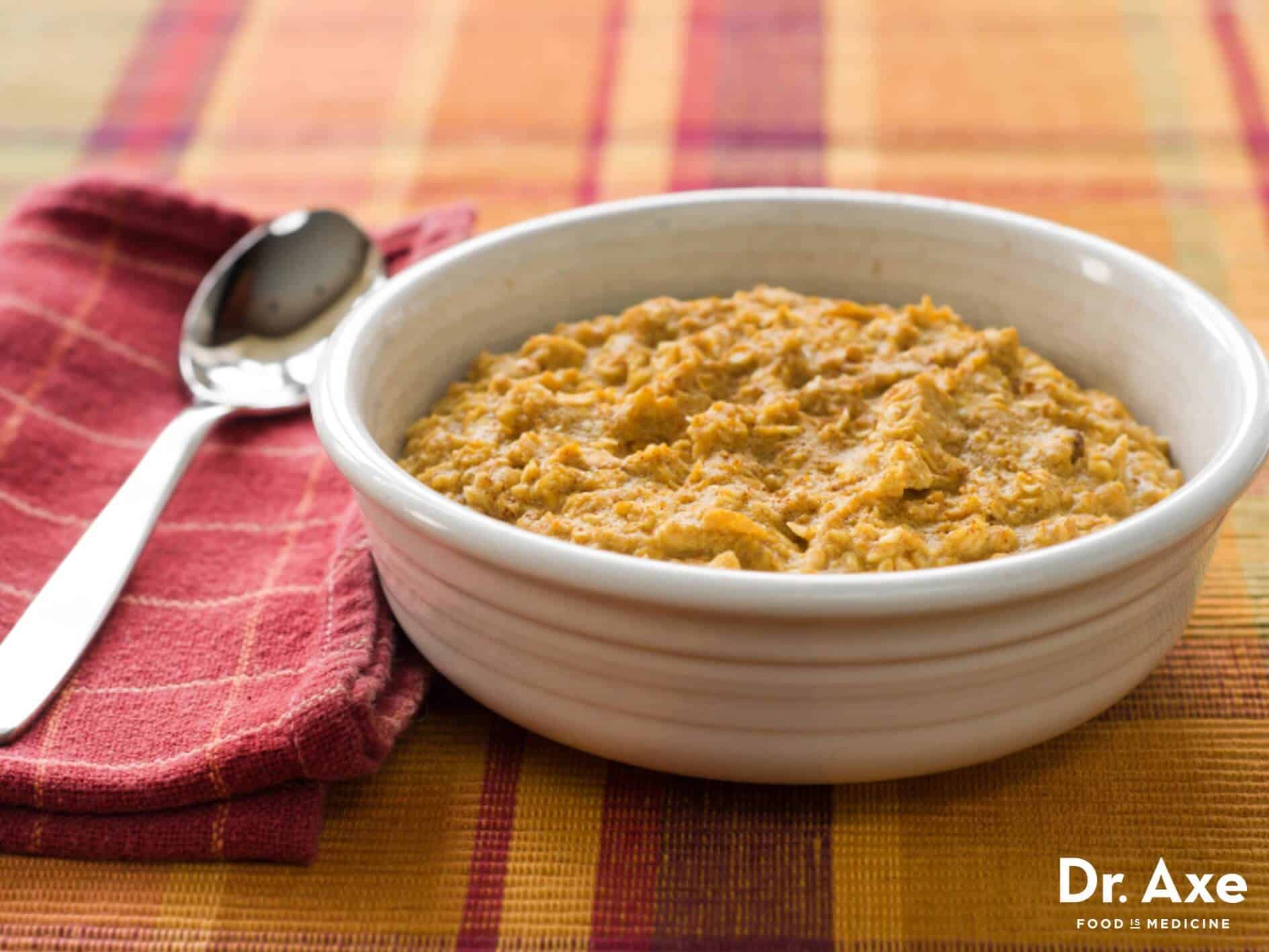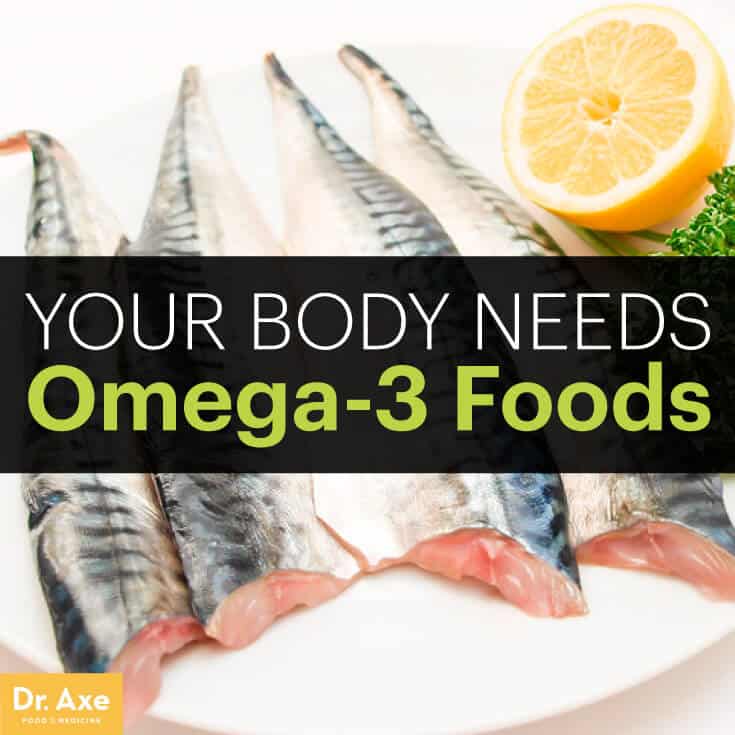Omega-3s are “essential” fatty acids because the body isn’t capable of producing them on its own. Therefore, we must rely on omega-3 foods in our diet to supply these extremely beneficial compounds.
There are actually three different types of “omega-3s”: ALA (alpha-linolenic acid), DHA (docosahexaenoic acid) and EPA (eicosapentaenoic acid). The preferred sources are DHA and EPA, the kinds found in seafood sources like salmon and sardines. ALA, on the other hand, is found in some plant foods, including certain nuts and seeds, as well as high-quality cuts of meat like grass-fed beef.
When it comes to getting enough omega-3s into your diet, I recommend eating plenty of omega-3 foods and also supplementing in most cases. Through a combination of both, my advice is to make sure you’re getting at least 1,000 milligrams a day of EPA/DHA and about 4,000 milligrams of total omega-3s (ALA/EPA/DHA combined).
What Makes Some Omega-3 Foods Better Than Others?
The human body is able to turn ALA into usable DHA and EPA to some degree, but this isn’t as efficient as getting DHA and EPA directly from food sources that provide it. It’s one reason why nutrition experts recommend consuming wild-caught fish several times per week, since many kinds of seafood are naturally high in DHA and EPA. (1)
While EPA and DHA are the preferred omega-3 sources, all types are beneficial and encouraged, so add nuts and seeds to your breakfast or have fish for dinner. Even after extensive research, it’s not totally clear how well ALA converts into EPA and DHA or if it has benefits on its own, but health authorities, like those at Harvard Medical School, still consider all sources of omega-3s crucial in the diet. (2)
Historically, we’ve seen that populations that consume the most omega-3 foods, like people in Okinawa, Japan, live longer and healthier lives than people who eat a standard diet low in omega-3s. The typical Okinawa diet — which consists of plenty of fish, sea vegetables and other fresh produce — is actually believed to have about eight times the amount of omega-3s that you’d find in the standard American diet, which is likely one reason why this population is considered one of the healthiest in human history.
Other populations that consume plenty of omega-3 foods include those living in the Mediterranean region, including Spanish, Italian, Greek, Turkish and French populations. Researchers even found that although the typical Mediterranean diet is high in overall fat and certain cardiovascular risks, people in these areas suffer much lower incidences of heart disease on average than Americans, perhaps due to the heart-healthy omega-3 foods that make regular appearances in their meals. (3)
Omega-3 Foods: The Best vs. The Worst
Take a look around any large supermarket and you probably notice that food labels now brag about their omega-3 content more than ever. While omega-3s are now artificially added to multiple kinds of processed foods — peanut butter, baby formula, cereal and some protein powders, for example — it’s still best to get your omega-3s from whole, real food sources, especially wild-caught seafood.
While not always ideal, natural sources of omega-3, here are some of the many foods that you might find now contain omega-3s to some degree thanks to being fortified with these fatty acids: pasteurized dairy products, fruit juices, conventional (non-organic or cage-free) eggs, margarine, soy milk and yogurt, bread, flours, weight-loss drinks, and many types of baby foods (since research suggests omega-3s help babies’ brains develop properly).
The sources of EPA and DHA in fortified foods usually come from microalgae. They naturally add a fishy aroma to foods, so these processed foods must undergo extensive chemical purifying preparations in order to mask the taste and smell. (4) This likely reduces or changes fatty acid and antioxidant content within the foods, making them inferior to unaltered, whole food sources.
Additionally, omega-3s are now added to animal feed to incorporate higher levels into consumer dairy, meat and poultry products. Since food manufacturers are aware that knowledge about the benefits of omega-3s is on the rise, we’ll likely continue to see more and more processed omega-3 foods in the years to come.
Dangers of an Omega-3 Deficiency
 Omega-3 foods are believed to help lower the risk for heart disease due to their inflammation-reducing abilities. They also are needed for proper neurological function, cell membrane maintenance, mood regulation and hormone production.
Omega-3 foods are believed to help lower the risk for heart disease due to their inflammation-reducing abilities. They also are needed for proper neurological function, cell membrane maintenance, mood regulation and hormone production.
This is the reason omega-3 foods are known as “good fat” sources, the kinds that provide polyunsaturated fatty acids (PUFAS) known as alpha-linolenic acids. While most consume enough of the other kinds of essential fatty acids known as omega-6s (found in modified cooking oils like canola, sunflower and safflower oil, plus some nuts), most people are low in omega-3s and can afford to up their intake of omega-3 foods.
Studies show that a lower ratio of omega-6s to omega-3s is more desirable to reduce the risk of many chronic diseases that have become epidemics in most Western societies. For example, researchers from The Center for Genetics, Nutrition and Health of Washington, D.C. found that the lower the omega-6/omega-3 ratio was in women, the lower their risk of breast cancer. A ratio of 2:1 suppresses inflammation in patients with rheumatoid arthritis, and a ratio of 5:1 has a beneficial effect on patients with asthma. (5)
The average person suffers from omega-3 deficiency because she doesn’t include the best omega-3 foods in her weekly diet, such as fish, sea vegetables/algae, flaxseeds or grass-fed meat. Depending on whom you ask, these numbers range, but I advise people that the ideal ratio of omega-6 foods to omega-3 foods is about equal to, or at least at, a 2:1 ratio of omega-6s to omega-3s.
What are the risks of consuming too little omega-3s (plus too many omega-6s)?
- Inflammation (sometimes severe)
- Higher risk for heart disease and high cholesterol
- Digestive disorders
- Allergies
- Arthritis
- Joint and muscle pain
- Mental disorders like depression
- Poor brain development
- Cognitive decline
The Benefits of Natural Omega-3 Foods
Many studies show that omega-3 fatty acids help maintain the following: (6)
- Cardiovascular health (by lowering blood pressure, cholesterol, plaque buildup in the arteries, and the chance of having a heart attack or stroke)
- Stabilizing blood sugar levels (preventing diabetes)
- Reducing muscle, bone and joint pain by lowering inflammation
- Helping balance cholesterol levels
- Improving mood and preventing depression
- Sharpening the mind and helping with concentration and learning
- Boosting immunity
- Treating digestive disorders like ulcerative colitis
- Reducing risk for cancer and helping prevent cancer reoccurence
- Improving appearance, especially skin health
Currently, there isn’t a set standard recommendation for how many omega-3s we need each day, so suggestions range from 500 to 1,000 milligrams daily depending on whom you ask. How easy is it to get these recommended amounts? To give you an idea, there are more than 500 milligrams of total omega-3s in one can of tuna fish and one small serving of wild-caught salmon.
What Are the Best Omega-3 Foods?
Here’s a list of the top 15 omega-3 foods (percentages based on 4,000 milligrams per day of total omega-3s): (7)
- Mackerel: 6,982 milligrams in 1 cup cooked (174 precent DV)
- Salmon Fish Oil: 4,767 milligrams in 1 tablespoon (119 percent DV)
- Cod Liver Oil: 2.664 milligrams in 1 tablespoon (66 percent DV)
- Walnuts: 2,664 milligrams in 1/4 cup (66 percent DV)
- Chia Seeds: 2,457 milligrams in 1 tablespoon (61 percent DV)
- Herring: 1,885 milligrams in 3 ounces (47 percent DV)
- Salmon (wild-caught): 1,716 milligrams in 3 ounces (42 percent DV)
- Flaxseeds (ground): 1,597 milligrams in 1 tablespoon (39 percent DV)
- Tuna: 1,414 milligrams in 3 ounces (35 percent DV)
- White Fish: 1,363 milligrams in 3 ounces (34 percent DV)
- Sardines: 1,363 milligrams in 1 can/3.75 ounces (34 percent DV)
- Hemp Seeds: 1,000 milligrams in 1 tablespoon (25 percent DV)
- Anchovies: 951 milligrams in 1 can/2 ounces (23 percent DV)
- Natto: 428 milligrams in 1/4 cup (10 percent DV)
- Egg Yolks: 240 milligrams in 1/2 cup (6 percent DV)
Other Natural Sources of Omega-3
- Nuts and Seeds with Omega-3s — In addition to walnuts, chia and flaxseeds, butternuts, brazil nuts, cashews, hemp seeds and hazelnuts have omega-3s in the form of ALA (although walnuts, flaxseeds and chia are definitely the better sources).
- Vegetables — Many vegetables, especially green leafy ones, are good sources of ALAs. While ALA omega-3 foods aren’t as good as those with DHA and EPA, these foods should still make regular appearances in your diet considering how much fiber and other nutrients they also contain. Some of the vegetables highest in omega-3s include Brussels sprouts, kale, spinach and watercress.
- Oils — Lots of oils contain omega-3s to some degree, usually in the form of ALAs. These include mustard oil, walnut oil and hemp oil. A newer vegetarian oil called algal oil is also gaining popularity as early research shows it’s easily converted to DHA in the body compared to other vegetarian omega-3s foods. (8)
How Do Different Omega-3 Fish Oils Compare?
Because there is such debate over waters being contaminated with toxins and pollutants like mercury, many people find it hard to get enough omega-3s from eating fish alone. This is one reason why some people prefer supplementing with fish oil in addition to eating some omega-3 foods.
The difference between “fish oil” and “cod oil” can be confusing. Fish oil and cod liver oil are actually two different oils, although they are molecularly similar and both extracted in the same way. The reason they are different is their sources: Fish oil is extracted from tuna, herring, cod or other deep-sea fish. Cod liver oil comes from the liver of cod fish only.
How do they compare nutritionally? Fish oil is a great source of omega-3 fatty acids EPA and DHA, but it doesn’t have much vitamin A or D. On the other hand, cod liver oil is lower in omega-3s very high in vitamins A and D.
According to some sources, cod liver oil contains about 8 percent EPA and 10 percent DHA, much less than fish oil, which has around 18 percent EPA and 12 percent DHA.
Due to its vitamin concentration, cod liver oil traditionally has been given to young children since the 1960s, since it helps support brain function and development. Because many people today suffer from vitamin D deficiency, cod liver oil has made a comeback. A lot of people who use cod liver oil rely on it in the winter months, when they spend less time outdoors, to supply a high level of absorbable vitamin D.
What is the ideal kind of fish oil if you want to supplement your diet? I believe that the best form of omega-3 fish oil contains astaxanthin (a powerful antioxidant that also helps stabilize fish oil), so my preferred choice is fish oil made from wild-caught pacific salmon, which has high levels of DHA/EPA and astaxanthin.
Recipe Ideas Using Omega-3 Foods
Salmon Patties Recipe
- 1 can Alaskan salmon
- 2 eggs
- 1 tablespoon olive oil
- 1/4 onion, chopped
- 1/4 box of Mary’s Gone Crackers, crumbled
DIRECTIONS:
- Place all ingredients into a bowl and mix together. Form into patties. Cook five minutes on each side.

Savory Baked Fish Recipe
- 6 white fish fillets, such as mahi mahi, grouper or snapper
- Sea salt and black pepper to taste
- 3 cloves garlic, finely minced
- 1/2 cup finely minced onion
- 3 tablespoons coconut oil
- 1 teaspoon onion powder
- 1 teaspoon lemon pepper seasoning
- 1/2 teaspoon paprika
- 1 (8 ounce can) fire-roasted diced tomatoes
- 4 tablespoons parsley
- 1 tablespoon apple cider vinegar
- 3 tablespoons grated raw cheese
- 3 tablespoons almond flour
DIRECTIONS:
- Preheat oven to 350 degrees F.
- Sauté the onions and garlic in coconut oil in small skillet over medium low heat until onion is transparent and soft.
- Purée fire-roasted tomatoes in blender. Add garlic/onion mix to blender with tomatoes and other herbs.
- Place fish in baking pan that has been coated with coconut oil. Generously brush fish with tomato sauce mixture.
- In a small bowl, mix flour and cheese together. Sprinkle cheese mixture over fish and bake for approximately 30 minutes.

Oatmeal with Chia Seeds
- 2/3 cup steel cut oats
- 2 cups coconut milk
- 1/2 teaspoon vanilla extract
- 1/2 cup pumpkin puree
- 1/2 tablespoon chia seeds
- Pinch of salt
- 1/2 teaspoon cinnamon
- 1/4 teaspoon ginger
- 1/8 teaspoon nutmeg
DIRECTIONS:
- Heat the oats and coconut milk in medium-sized pot to boil.
- Turn down to simmer and add pumpkin and chia.
- Simmer for 5–7 min.
- Add remaining spices, stirring regularly.
- Simmer for additional 5–7 mins.

Are There Potential Dangers/Side Effects of Consuming Omega-3 Foods?
Omega-3s are considered very safe and effective even when taken up to 20 grams at a time, but some people experience mild side effects when taking omega-3 fish oil supplements. Some side effects that can occur from omega-3 fish oil include:
- “Fish burps” or a fishy taste in your mouth (this is definitely the biggest complaint but shouldn’t happen if you take a high-quality supplement)
- Stomach pains or nausea
- Trouble going to the bathroom normally (diarrhea)
- Potential for excess bleeding if you take more than three grams per day
- Allergic reactions
- Changes in blood sugar levels (or complications with diabetes medications)
While most people won’t experience any side effects when consuming plenty of omega-3 foods and taking supplements daily, talk to your doctor about side effects you have when taking higher doses than the recommended amount. One thing to note is that you definitely shouldn’t take omega-3 supplements from fish oil if you have an allergy to most fish, since this runs the risk of causing a serious reaction.

